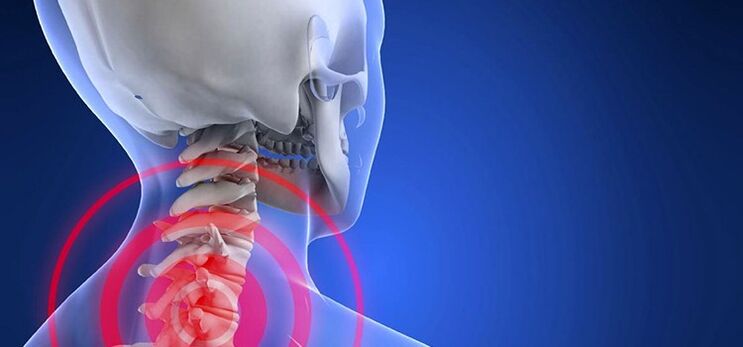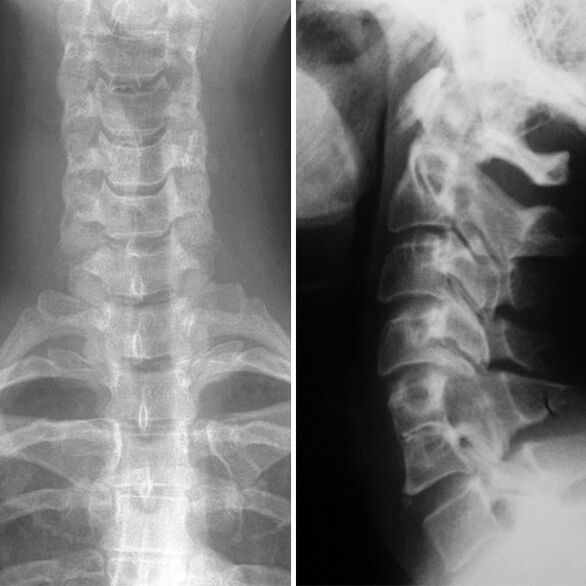
Osteochondrosis of the cervical region is one of the most common diseases of the spine, which can be explained by the large movement of this part of the body.As the disease develops, severe pain occurs, which significantly exacerbates the quality of human life.That is why it is so important in the first manifestations of pathology to consult a doctor.
Cervical back osteochondrosis clinic
The violation is progressive and consists of the appearance of dystrophic changes in the spinal discs.There are seven beads in this country that offer free head movements.Due to the increase in physical exercise or insufficient strong muscles, this spine often undergoes such a violation.
With the development of the disease, the metabolic processes in the spine are concerned, the strength and elasticity of the intervertebral disk disappear, and increased loads lead to the fact that cracks occur in the fibrous ring.As the process develops, extension or hernia occurs.
The degree of development
- First degree.The disease provokes few symptoms.A person feels minor pain in the neck, growing with the curves of the head.During examination, the doctor can identify a small muscle tension.
- Second degree.This form is characterized by vulnerable pain, and they can give it on hand or shoulder.This is due to a disk height violation that provokes nerve pliers.Pain syndrome becomes stronger when moving the head.Such a condition is characterized by headaches, increased weakness, decreased working capacity.
- Third degree.Anomaly manifestations are increasing many times, and the pain is constantly present.They can feel not only in the neck themselves, but also affect the shoulder or arm.The formation of a hernia leads to the weakness of the hands.A person complains of chronic fatigue and dizziness.On examination, the doctor may detect a violation of neck mobility.In addition, the patient has pain during palpation.
- Fourth degree.At this stage, the intervertebral disc is completely destroyed, which leads to the formation of connective tissue in its country.Also in the patient, dizziness increases significantly, coordination of movements is disturbed and there is noise in the ear.Such symptoms are a consequence of the use of vertebral artery in the pathological process - it is what is responsible for brain and brain nourishment.
Reason
Under the influence of various factors, the load on the cervical separation increases.Muscles are trying to compensate for this process, which provokes pain and problems with blood circulation.Because of this, degenerative processes arise.
The main causes of the disease are as follows:
- lack of motor activity;
- violation of metabolism;
- improper behavior;
- Excess weight;
- scoliosis;
- systematic muscle tension;
- stressful situations;
- dysplastic connective tissue abnormalities;
- problems with blood circulation in the neck;
- inheritance;
- uncontrolled physical activity;
- Spine abnormalities.
In spite of popular belief, osteochondrosis can be identified not only in older people.Today, such a violation is not uncommon in children and adolescents either.Moreover, the number of cases of disease in humans is 18-30 years old.
Symptoms and signs of illness
These or other symptoms of osteochondrosis are present in almost every person.If they are accompanied by pronounced pain, you should consult a doctor immediately.Signs of pathology include:
- Pain in the neck.They can give to the back of the head, shoulder, eyes or ears.Very often they feel during movements.Sometimes there is pain of a pulsating nature.
- Pain in the hands.The discomfort can also be felt in the shoulder area, brush, forearm, and remains at night.
- Violation of the activity of the hands and fingers.A person may lose the sensitivity and strength of the muscle.
- Morning muscle tension.
- Noise in the ears.
- Headaches.As a rule, they begin to feel at the back of the head, and then feel in temples and crowns.
- Numbness and tingling in the limbs.
- Fainting, dizziness, darkening in the eye.Such signs most often appear with careless head movements.
- Numbness of language.
- Listening and worse vision.
- Pain in the heart area.
- Increased connective tissue size in the neck.
- Disordishes sleep, memory, attention.
- Sound change - the appearance of moisture, sound weakening, etc.
Symptoms of cervical osteochondrosis
Violations of this spine are characterized by such manifestations:
- systemic headaches;
- International neuralgia;
- pressure;
- loss of coordination of movements;
- dizziness;
- Chronic fatigue;
- heart pain;
- infectious pathology;
- ignition points in front of the eyes;
- noise in the ears;
- numbness of the fingers;
- Pain in the hands and shoulders.
This form of osteochondrosis provokes many syndromes and can lead to problems in the functioning of certain organs.
For example, this pathology often provokes heart disease.Therefore, if these symptoms appear, you should consult a doctor immediately.
syndromes
In addition to general manifestations, a number of syndromes are characteristic of cervical osteochondrosis.Thanks to these signs, it is possible to make an accurate diagnosis and choose therapy.
Koreshka
This condition is often called cervical radiculus.Resting syndrome is the result of pinching nerves in the neck.As this process progresses, the pain spreads down, reaching the shoulder blade.They can affect the forearms and fingers.Sometimes patients complain about goosebumps and tingling.
The manifestations of the violation are determined by the location of the pathology.So when you clamping the roots of the central nerve, swelling occurs, which affects the big, middle and index fingers.If the roots of the shoulder nerve are touched, the process touches the little finger and the ring finger.
Reflex
This condition is characterized by severe pain that localizes in the neck or NAP.Often the discomfort intensifies after a sharp movement.As examples of such a condition, it is worth giving pain after sleep when the patient turns his head severely.Sycles can also be felt on the chest or shoulder.
Vail artery syndrome
The main symptom is headache that pulsating or burning.They often apply to the back of the head, darkness, whiskey.Also, embarrassment is often felt over the eyebrows.Pain syndrome intensifies after a long movement.The embarrassment also grows after it is in an unpleasant position.With a decrease in immunity, vomiting occurs, hearing problems and violations in the functioning of the vestibular apparatus are possible.Also, vertebral artery syndrome often provokes vision problems.Pain in the eye may appear.
cardiac
First of all, symptoms of pectoris appear.That is why there is a threat of non -romantic treatment of angina pectoris rather than eliminating the leading cause of discomfort.
The development of cardiac syndrome is provoked by a top of the roots of the diaphragmatic nerve muscle or chest.Pain in the form may occur that feel for a long time.Moreover, embarrassment grows with sneezing, coughing, incorrect head movements.
This syndrome is associated with tachycardia and extrasystole.In such a situation, the pain does not diminish even after using antianginal medicines.If you make a cardiogram during an attack, there will be no symptoms of circulatory problems in it.
Complications and consequences
The most dangerous complications include:
- Extending discs that provoke the formation of a hernia.
- Disk gap with pinch nerves and blood vessels.In this condition, the spinal cord can squeeze, which is very dangerous to life.
- Radiculopathy - violation of nerve roots.
- Osteophytes formation - so -called rivets in the beads.As a result, paresis and paralysis often occur.
Dunn osteochondrosis can be a dangerous complication of this form of duphitr.
In this case, a person's tendons lose the ability to stretch.As a result, the fingers are deformed and cannot function properly.

Troubleshooting
To diagnose a violation, you should contact a neurologist.The specialist will describe such types of research:
- Radiography;
- calculated tomography;
- Magnetic resonance tomography.
To assess the condition of the cervical vessels, ultrasound dopplerography can be performed.For problems with blood circulation, it is worth performing reoencephalography.You should also contact the optometrist, who will perform the lower inspection of the eye.
How to handle
To get the desired results, the treatment must be comprehensive.To do this, use medical and not -drug techniques.Doctors often prescribe medicines that help eliminate pain and inflammation.
Be sure to accept funds to normalize cerebral circulation.If the pathology causes muscle tension, you should get relaxing agents.In addition, vitamin complexes are very useful.
An important role in the treatment of the disease is played by the effects of physiotherapy.Applications for paraffin and electrophoresis are particularly useful.Also, water procedures, hirudotherapy, massage, acupuncture, magnetotherapy are often often prescribed.However, the most effective method of treatment is considered therapeutic gymnastics.In particularly difficult situations, you cannot do without surgical intervention.
The cervical spine osteochondrosis belongs to the category of very dangerous disorders because it not only causes pain, but is also able to lead to the development of serious consequences.To avoid the appearance of complications, if any neck discomfort, you should seek medical help.



































